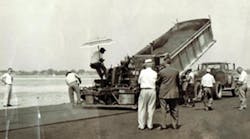The May 1964 issue of Hydraulics & Pneumatics described an asphalt paving machines rugged enough to withstand severe jarring of trucks backing into them, yet sensitive enough to produce smooth, even surfaces. A good, finished surface must be true to grade (elevation in the longitudinal direction) and transverse slope.
The electrohydraulic paver-finisher uses electrical signals to control the machine’s paving elevation through hydraulic valves. A sensing device rides on reference surfaces to measure grade and maintain slop relationship. Signals from the grade and slope sensors actuate two solenoid valves. These valves control cylinders that control the paver screed elevation and slope with respect to the reference. Four-way, 3-position, open-center, solenoid valves were selected instead of electrohydraulic valves, because they provide required positioning accuracy, produce less heat, and are readily available as off-the-shelf items.
One system controls grade, another controls slope. Both systems are supplied by a fixed displacement, belt-driven, gear pump delivering 1 gpm at 1000 psi. The pump is part of a package, which includes a reservoir, filter, and a flow control valve, which insures constant flow regardless of engine speed.
Grade Control
An electrical potentiometer type sensor is attached to the forward end of one side arm and rides on a reference surface such as a string line or a floating beam. The sensor is connected to a manually controlled potentiometer, forming a bridge circuit. When the elevation of the arm changes with respect to the reference surface, the sensor follower grid rotates, unbalancing the bridge and generating an error signal.
An electronic amplifier amplifies the error signal and energizes a solenoid-operated, hydraulic valve. The valve directs pressure fluid to a vertical cylinder attached to the tractor frame and forward end of the side arm. The side arm goes up or down until it again reaches the preset elevation.
Slope Control
To control slope, a crossbeam extends across the machine directly above the forward end of the side arms and is connected to them with tie rods. A pendulum sensor on the beam operates an electrical potentiometer that is wired to a manual potentiometer in the control panel to form a bridge circuit similar to that of the grade follower bridge. An error signal from the slope bridge is amplified to energize a solenoid valve, as in the grade control system. The valve supplies fluid to the cylinder opposite the grade-positioning cylinder. The beam and side arms are held at the desired slope even though the tractor may tilt back and forth over rough grade.
Reference Signals
A string line or wire produces the most accurate grade elevation where the sub-base or grade is extremely rough or an absolute reference is required. Where the sub-base is not too rough, a free-floating beam produces an accurate grade elevation.
The floating beam is 30ft. long and is supported every 2 ½ ft. by springs that ride on shoes towed by the beam. As the shoes ride over irregular grades, the spring-supported beam gives a mean average height above the grade as a reference plane.
Control Panel Design
The automatic grade and slope control is operated from a panel mounted on a platform at the top of the machine. From this panel, the operator can change the set points of each electrical bridge and dial additional slope as the machine moves around a banked curve. The operator can dial any slope from 0-10%. The slope can be changed while the paver is standing or moving. The machine can also be switched to manual operation for crossing intersections or paving sections of road that do not conform to smooth transitions.

